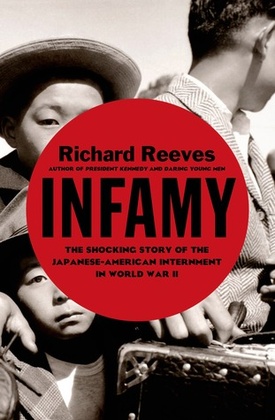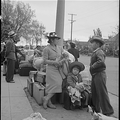Why, you might ask, do we need yet another book about “camp”? Richard Reeves, author of the recently released INFAMY: The Shocking Story of the Japanese American Internment in World War II, explains his reasons in the book’s introduction: “I finally decided to write this book when I saw that my country, not for the first time, began turning on immigrants, blaming them for the American troubles of the day. Seventy years ago, it was American Japanese, most of them loyal to their new country; now it is Muslims and Hispanics.”
With what’s happening today as his motivation, Reeves sets out to tell the story of what happened to Japanese Americans when they were forcibly removed and indefinitely detained in ten American-style concentration camps located in the badlands of America from 1942 to 1946. He does this by culling and gathering factual information from numerous books, articles, and sources already in existence, and presenting them in a chronological narrative that is educational, eye-opening, disturbing, and deeply painful, especially if you have family who lived through and survived this experience.
Much of what he has written is not new to me, but the fact that he has put it all in one place—with numerous human stories that I had never read or heard about before—made INFAMY much more than “the same old, same old” book about camp. All the major topics and players are covered: Pearl Harbor, FDR and all the president’s men, General Dewitt, fear and racism, the incarceration, the role of war-time JACL leaders, “loyalty vs. disloyalty,” “No-No Boys” and Draft Resisters, the 100th/442nd/MIS Nisei soldiers and the rescue of “The Lost Battalion,” and the discrimination and struggles Japanese Americans faced when they returned home after the war.
What brings the book to life are the human stories that Reeves weaves into the historical narrative: Nisei Stanley Hayami’s poignant letters from camp and from the battlefields in France and Italy; the Nisei youth who had to tell his father that the nursery they were forced to sell for $1,000 before camp was now being offered back to them for $26,000, and watching him burst into tears at this news; the Nisei veteran’s emotional reunion with a Jewish concentration camp survivor whom he had rescued at Dachau 50 years earlier; and even a brief mention of my father, Hiroshi Kashiwagi, and his traumatic story of his mother having all her teeth pulled by a ruthless dentist just before the family was taken away. (This was quite a surprise since I was not aware that my dad would be mentioned in this book.)
If you’re a JA of the post-war younger generation(s) and have often wondered why your parents and grandparents rarely talked about what happened to them in “camp,” this book will give you the answers and fill in many blanks. The truth of what happened is heart-wrenching and painful, yes. But it’s important for us—and all Americans—to understand how this happened, and whether it can happen again.
“Many Americans, I among them,” writes Reeves at the end of his book, “believe or fear that in times of crisis, real or imagined, innocent members of any group could again be imprisoned without charges as a matter of ‘military necessity.’ The Japanese American experience clearly answered the question, ‘Could it happen here?’ It did.”
INFAMY: The Shocking Story of the Japanese American Internment in World War II by Richard Reeves
(New York City: Henry Holt and Co., 2015, 368pp., hard cover)
© 2015 Soji Kashiwagi






